Outcomes after induction failure in childhood acute lymphoblastic leukemia
- PMID: 22494120
- PMCID: PMC3374496
- DOI: 10.1056/NEJMoa1110169
Outcomes after induction failure in childhood acute lymphoblastic leukemia
Abstract
Background: Failure of remission-induction therapy is a rare but highly adverse event in children and adolescents with acute lymphoblastic leukemia (ALL).
Methods: We identified induction failure, defined by the persistence of leukemic blasts in blood, bone marrow, or any extramedullary site after 4 to 6 weeks of remission-induction therapy, in 1041 of 44,017 patients (2.4%) 0 to 18 years of age with newly diagnosed ALL who were treated by a total of 14 cooperative study groups between 1985 and 2000. We analyzed the relationships among disease characteristics, treatments administered, and outcomes in these patients.
Results: Patients with induction failure frequently presented with high-risk features, including older age, high leukocyte count, leukemia with a T-cell phenotype, the Philadelphia chromosome, and 11q23 rearrangement. With a median follow-up period of 8.3 years (range, 1.5 to 22.1), the 10-year survival rate (±SE) was estimated at only 32±1%. An age of 10 years or older, T-cell leukemia, the presence of an 11q23 rearrangement, and 25% or more blasts in the bone marrow at the end of induction therapy were associated with a particularly poor outcome. High hyperdiploidy (a modal chromosome number >50) and an age of 1 to 5 years were associated with a favorable outcome in patients with precursor B-cell leukemia. Allogeneic stem-cell transplantation from matched, related donors was associated with improved outcomes in T-cell leukemia. Children younger than 6 years of age with precursor B-cell leukemia and no adverse genetic features had a 10-year survival rate of 72±5% when treated with chemotherapy only.
Conclusions: Pediatric ALL with induction failure is highly heterogeneous. Patients who have T-cell leukemia appear to have a better outcome with allogeneic stem-cell transplantation than with chemotherapy, whereas patients who have precursor B-cell leukemia without other adverse features appear to have a better outcome with chemotherapy. (Funded by Deutsche Krebshilfe and others.).
Figures


Comment in
-
Attacking remaining challenges in childhood leukemia.N Engl J Med. 2012 Apr 12;366(15):1445-6. doi: 10.1056/NEJMe1200989. N Engl J Med. 2012. PMID: 22494125 No abstract available.
References
-
- Möricke A, Zimmermann M, Reiter A, et al. Long-term results of five consecutive trials in childhood acute lymphoblastic leukemia performed by the ALL-BFM study group from 1981 to 2000. Leukemia. 2010;24:265–84. - PubMed
-
- Schmiegelow K, Forestier E, Hellebostad M, et al. Long-term results of NOPHO ALL-92 and ALL-2000 studies of childhood acute lymphoblastic leukemia. Leukemia. 2010;24:345–54. Erratum, Leukemia 2010; 24:670. - PubMed
Publication types
MeSH terms
Substances
Grants and funding
- MC_U137686856/MRC_/Medical Research Council/United Kingdom
- CA30969/CA/NCI NIH HHS/United States
- CA98543/CA/NCI NIH HHS/United States
- U10 CA098413/CA/NCI NIH HHS/United States
- CA21765/CA/NCI NIH HHS/United States
- P30 CA021765/CA/NCI NIH HHS/United States
- 14840/CRUK_/Cancer Research UK/United Kingdom
- U10 CA029139/CA/NCI NIH HHS/United States
- U10 CA098543/CA/NCI NIH HHS/United States
- U10 CA030969/CA/NCI NIH HHS/United States
- CA98413/CA/NCI NIH HHS/United States
- P01 CA068484/CA/NCI NIH HHS/United States
- CA13539/CA/NCI NIH HHS/United States
- U10 CA013539/CA/NCI NIH HHS/United States
- 5P01CA068484/CA/NCI NIH HHS/United States
- CA29139/CA/NCI NIH HHS/United States
LinkOut - more resources
Full Text Sources
Other Literature Sources
Medical
